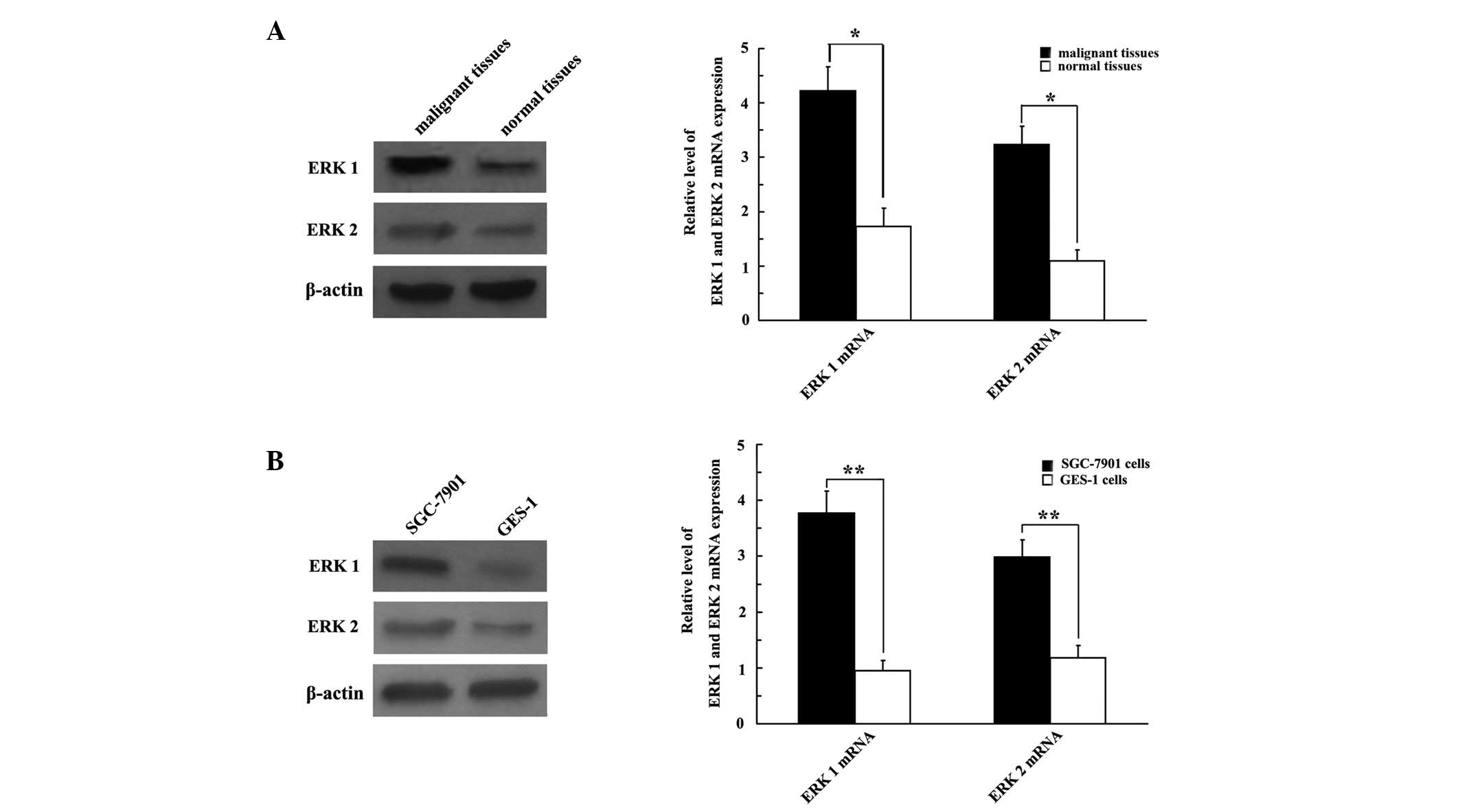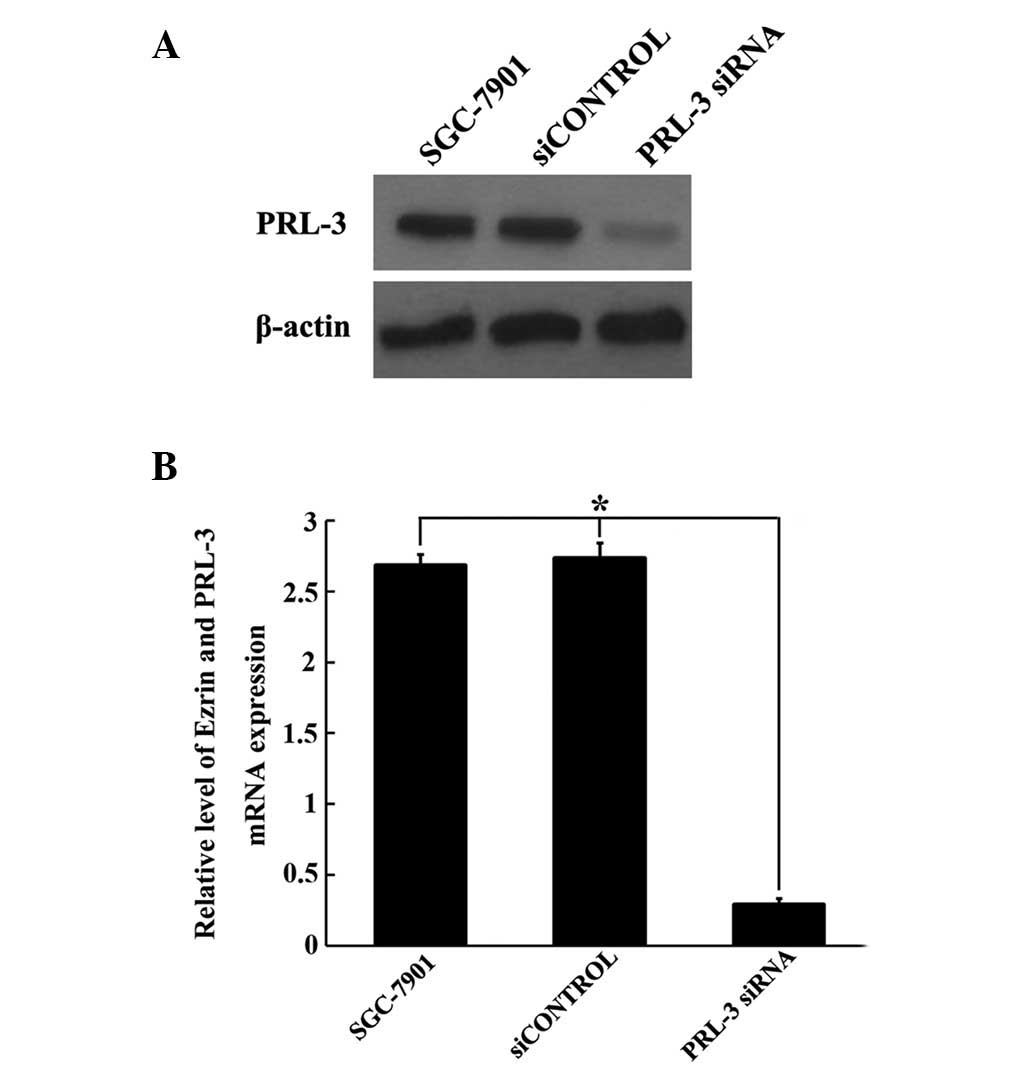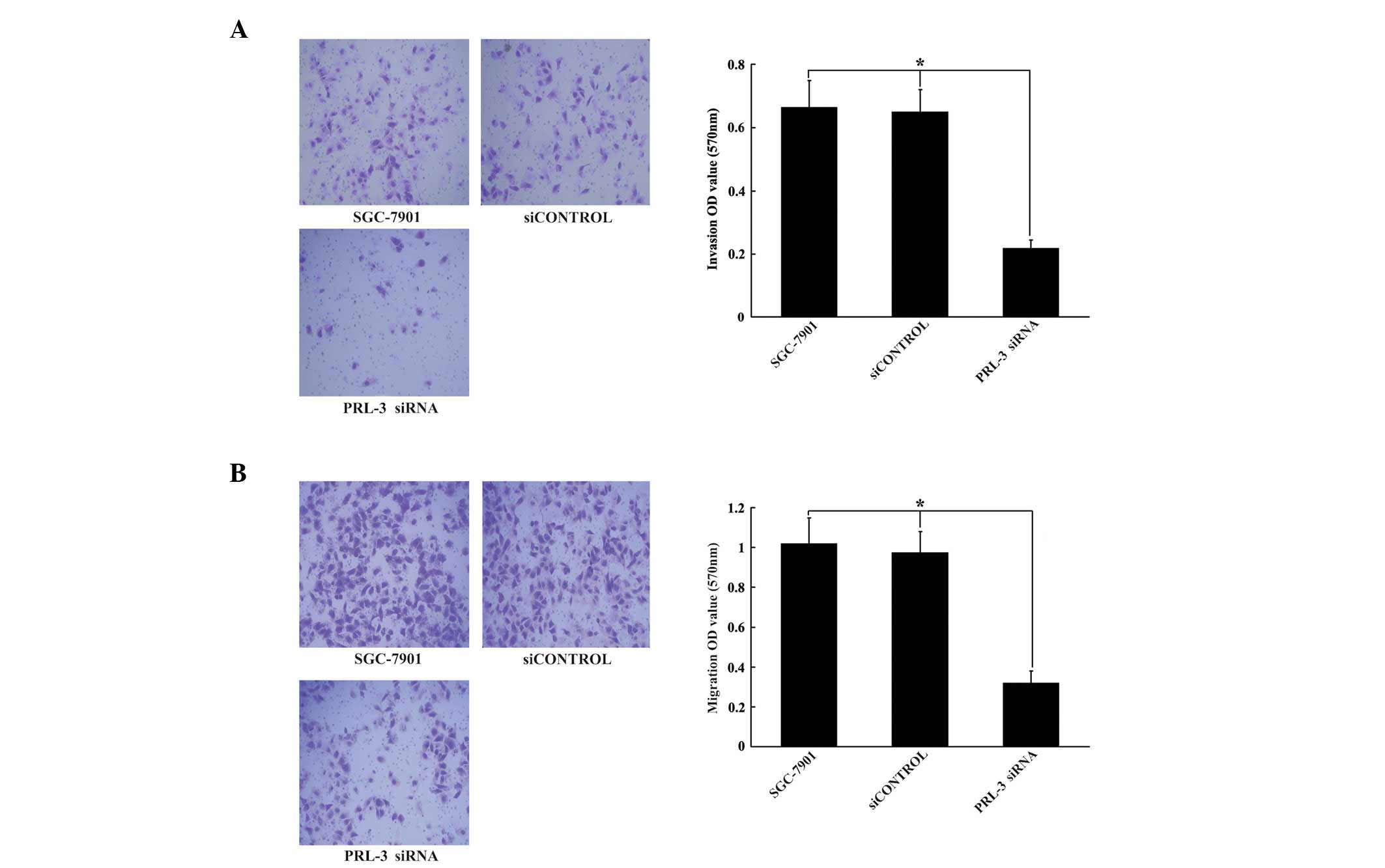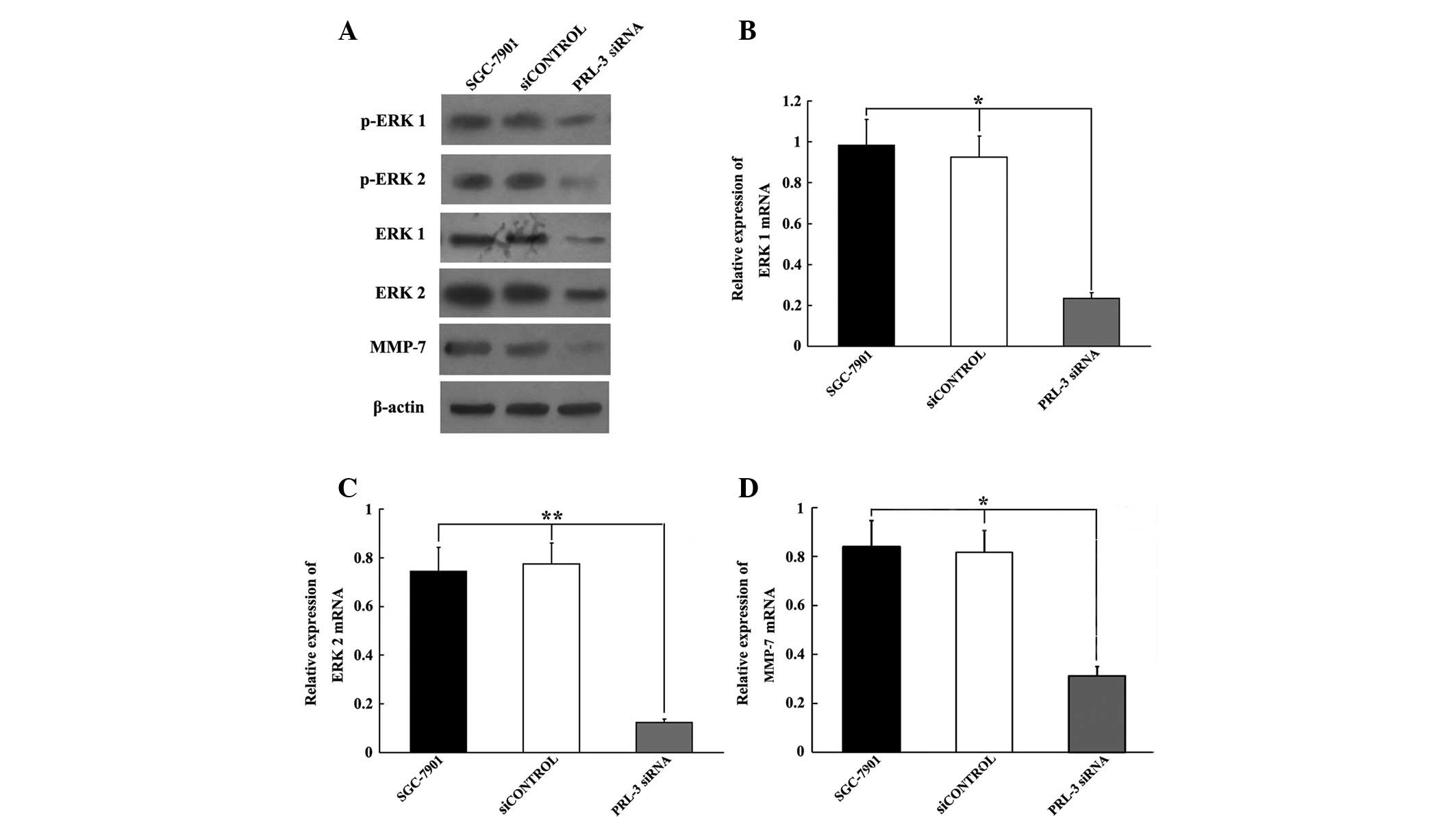RNAi‑mediated knockdown of PRL‑3 inhibits cell invasion and downregulates ERK 1/2 expression in the human gastric cancer cell line, SGC‑7901
- Authors:
- Published online on: April 10, 2013 https://doi.org/10.3892/mmr.2013.1420
- Pages: 1805-1811
Abstract
Introduction
Gastric cancer (GC) is one of the most common types of cancer globally. It is considered to be the second most frequent cause of cancer-related mortality worldwide (1–3). The invasion and migration of GC are important factors leading to tumor recurrence and affecting prognosis; however, the molecular pathogenesis of GC metastasis is not well understood. For this reason, understanding the mechanisms underlying GC as well as the identification of novel molecular targets are of great importance.
Phosphatase of regenerating liver-3 (PRL-3), a metastasis-associated protein, belongs to the PRL family of protein tyrosine phosphatases (PTP), which includes two other members, PRL-1 and PRL-2 (4). The PTP superfamily of phosphatases includes a large group of enzymes important for the regulation of a wide variety of cell mechanisms, including signal transduction, the cell cycle, differentiation, cell transformation, adhesion and motility (5,6). Evidence has accumulated for the association of PRL-3 with oncogenic states, and several studies have linked its expression to human cancer progression and metastasis, such as in the case of malignant melanoma, as well as pancreatic, ovarian, breast and nasopharyngeal cancer (7–11). In a previous study, we examined the expression of PRL-3 in primary GC tissues and in peritoneal metastases, and found that PRL-3 expression was significantly higher in primary gastric carcinoma with peritoneal metastasis than in peritoneal metastasis-negative gastric carcinoma (12). However, little is known regarding the molecular mechanisms by which PRL-3 promotes motility, invasion and metastasis.
The extracellular signal-regulated kinase 1/2 (ERK 1/2), part of the mitogen-activated protein kinase (MAPK) family, is well-known for its role in numerous cell processes, such as cell migration, invasion and proliferation (13,14). One suggested mechanism whereby the ERK 1/2 pathway promotes invasiveness in tumor cells is through the upregulation of matrix metalloproteinases (MMPs), for extracellular matrix remodeling (15), which are important in tumor metastasis (16). A decrease in cell adhesion and proteolytic degradation of collagen by MMPs promotes the invasive migration of cells through the extracellular matrix (17). PRL-3 has previously been described as one of the PRLs that are also capable of degrading the extracellular matrix; however, the molecular details remain unclear (7). Previously, it was demonstrated that an increased PRL-1 expression results in the activation of ERK1/2, which stimulates MMP production, and increases cell invasion and migration (18). It is known that PRL-3 has ≥75% amino acid sequence similarity with PRL-1 and PRL-2 (19). Therefore, it is also necessary and crucial to determine the relationship between PRL-3, ERK 1/2 and MMP expression in human GC.
In the present study, we employed siRNA targeting PRL-3 to explore the potential of new therapeutic targets in the treatment of GC. Our results suggested that knockdown of PRL-3 was able to inhibit GC invasion and migration, and significantly decrease ERK 1/2 and MMP-7 expression, which provides novel insights into tumorigenesis and may ultimately lead to more effective therapies.
Materials and methods
Gastric tissues, cell lines and cultures
Human gastric adenocarcinoma cancer cell lines, SGC-7901, MKN-45, MKN-28 and BGC-823, were obtained from the Type Culture Collection of the Chinese Academy of Sciences (Shanghai, China). The human gastric mucosa cell lines, GES-1 and HFE-145, were preserved in our central laboratory. Cells were cultured in Dulbecco’s Modified Eagle’s medium (DMEM, Gibco-BRL, Carlsbad, CA, USA) containing 10% fetal bovine serum (FBS), penicillin (100 U/ml) and streptomycin (100 μg/ml). Cells were incubated at 37°C in a humidified incubator with 5% CO2. All human gastric tissue samples, including eight gastric tissues and 20 malignant tissues, were obtained from the General Surgery Department of the First Affiliated Hospital of Nanchang University (Nanchang, China). All samples were obtained with informed consent and approved by the hospital institutional review board. The tissues were stored in liquid nitrogen following removal from patients.
Plasmids and transfection
The human PRL-3-specific siRNA was based on NCBI reference sequences (GenBank: PRL-3, NM_032611). The siRNA sequences used for PRL-3 gene silencing were designed based on published data, as follows: Sense: 5′-GATCCGTGACCTATGACAAAACGCTTCAA GAGAGCGTTTTGTCATAGGTCACTTTTTGGAAA-3′ and antisense: 5′-AGCTTTTCCAAAAAGTGACCTATGACAAA ACGCTCTTTGAAGCGTTTTGTCATAGGTCACG-3′ (20). The negative control sequences were as follows: Sense: 5′-GAT CCGGTTATGTACAGGAACGCATTCAAGAGATGCGTT CCTGTACATAACCTTTTTGGAAA-3′ and antisense: 5′-GCCAATAGATGTCCTTGCGTAAGTTCTCTACGCAA GACATGTATTGGAAAAACCTTTTCGA-3′. All siRNA transfections were performed using Lipofectamine 2000 (Invitrogen Life Technologies, Carlsbad, CA, USA) in Opti-MEM (Invitrogen Life Technologies) according to the manufacturer’s instructions, with a final siRNA concentration of 100 nM.
Quantitative real-time polymerase chain reaction (qRT-PCR) analysis
Total RNA from tumor cells or tissues was isolated with a total RNA extraction kit (Sangon Biotech, Shanghai, China) according to the manufacturer’s instructions. The primer sequences for qRT-PCR analysis were designed and synthesized as follows: Forward: 5′-CACGCTCAGCACCTTCATTG-3′ and reverse: 5′-GGTGAGCTGCTTGCTGTTGA-3′ for PRL-3; forward: 5′-CGCTACACGCAGTTGCAGTACA-3′ and reverse: 5′-AAGCGCAGCAGGATCTGGA-3′ for ERK 1; forward: 5′-TGTTCCCAAATGCTGACTCCAA-3′ and reverse: 5′-TCGGGTCGTAATACTGCTCCAGATA-3′ for ERK 2; forward: 5′-TGGACGGATGGTAGCAGTCT-3′ and reverse: 5′-TCTCCATTTCCATAGGTTGGAT-3′ for MMP-7; forward: 5′-GGCGGCACCACCATGTACCCT-3′ and reverse: 5′-AGGGGCCGGACTCGTCATACT-3′ for β-actin. RNA was first retrotranscribed using the TaqMan® Reverse Transcription kit (Applied Biosystems, Carlsbad, CA, USA), and then RT-PCR was carried out using the TaqMan SYBR-Green master mix (Applied Biosystems). The relative expression of the mRNA was normalized to β-actin mRNA. The threshold cycle value (Ct) was defined as the fractional cycle number at which the fluorescence passed an invariable threshold. The comparative Ct method was used to calculate the relative abundance of mRNA compared with that of β-actin expression (21).
Western blot analysis
The cells were harvested, washed twice with 1X PBS and lysed in 100 μl radioimmunoprecipitation assay (RIPA) lysis buffer. Protein concentrations were determined using a bicinchoninic acid (BCA) kit (Tiangen, China). Proteins were resolved by 10% sodium dodecyl sulphate-polyacrylamide gel electrophoresis (SDS-PAGE) and transferred to polyvinylidene difluoride (PVDF) membranes (Roche Diagnostics GmbH, Mannheim, Germany), which were then blocked with 5% non-fat milk in Tris-buffered saline for 3 h, and incubated overnight with primary antibodies. The secondary antibodies used were horseradish peroxidase-conjugated goat anti-rabbit or -mouse IgG from Tiangen (Beijing, China). Membranes were incubated with the secondary antibodies for 1 h at room temperature, and proteins were detected using an ECL Western Blotting Analysis system (Amersham Biosciences Corp., Piscataway, NJ, USA).
Cell migration and invasion analysis
Cell migration assays were performed using 8.0-μm pore size Transwell inserts (Costar, Cambridge, MA), with certain modifications. Cell invasion was investigated using Matrigel-coated 8.0-μm filter invasion chambers (BD Biosciences, San José, CA, USA). Cells were incubated for 24 h (for migration assay) or 48 h (for invasion assay) at 37°C in a humidified atmosphere of 5% CO2. Cells on the upper surface of the membrane were removed using cotton tips after the indicated incubation times. The migrant cells attached to the lower surface were stained with crystal violet (500 μl of 5 mg/ml crystal violet dissolved in 20% methanol) and incubated for 30 min. Cells were then soaked in 33% ice-cold acetic acid and oscillated for 10 min. The ice-cold acetic acid was then assessed by measuring the absorbance at 570 nm using a microplate reader (Tecan, Shanghai, China).
Statistical analysis
Statistical analyses were carried out using SPSS version 16.0 (SPSS, Inc., Chicago, IL, USA). The data are expressed as the means ± standard deviation, and the significance of the data was determined by one-way ANOVA analysis. P<0.05 was considered to indicate a statistically significant difference.
Results
Gastric cell lines express variable levels of PRL-3
We first examined the protein and mRNA expression levels of PRL-3 in six gastric cell lines, using western blot analysis and qRT-PCR. The six gastric cell lines included two normal gastric cell lines, GES-1 and HFE-145, and four malignant human GC cell lines with different degrees of cell differentiation, BGC-823, MKN-28, SGC-7901 and MKN-45 (SGC-7901 and MKN-45 were low-grade cell lines, and BGC-823 and MKN-28 were high-grade cell lines). Among the six gastric cell lines that expressed PRL-3 at various levels, SGC-7901 cells demonstrated the highest level of PRL-3 protein (Fig. 1A) and mRNA (Fig. 1B) expression, while GES-1 cells exhibited the lowest PRL-3 protein and mRNA expression; SGC-7901 cell PRL-3 mRNA expression was 4.602-fold greater compared with the GES-1 cell line (P<0.05). Therefore, we selected the SGC-7901 cell line for subsequent RNA interference studies.
ERK 1/2 is highly expressed in GC samples
We examined GC cell lines and tissues to elucidate whether ERK 1/2 was expressed in GC. The results revealed that the expression of ERK 1/2 protein was upregulated in both GC tissues and cell lines (Fig. 2A and B, respectively), compared with normal gastric tissues and cell lines. The qRT-PCR analysis revealed that the SGC-7901 cell line exhibited strong ERK 1/2 mRNA expression; ERK 1 and ERK 2 mRNA were 3.968- and 2.525-fold greater, respectively, compared with the GES-1 cell line (P<0.01; Fig. 2B). Consistently, ERK 1/2 mRNA was overexpressed in malignant tissues compared with normal gastric tissues (P<0.05; Fig. 2A).
Identification of the efficiency of PRL-3 siRNA
As the PRL-3 levels were significantly higher in tumor cells compared with normal cells, we aimed to determine whether synthetic PRL-3 siRNA inhibited the expression of the PRL-3 gene in GC cells. To examine the efficiency of the specific PRL-3 siRNA, we used scrambled siRNA as the control. Following 48 h of siRNA transfection, PRL-3 mRNA and protein expression levels were measured by qRT-PCR and western blot analysis, respectively. As shown in Fig. 3, PRL-3 siRNA was capable of specifically and efficiently suppressing PRL-3 expression at the mRNA and protein level, compared with cells treated with siCONTROL and untreated cells (P<0.05; Fig. 3). Considering the significant silencing effect of PRL-3 siRNA, we used this siRNA for subsequent experiments.
Downregulation of PRL-3 inhibits invasion and migration of SGC-7901 human GC cells
To investigate the molecular mechanisms by which PRL-3 promotes cell invasion and migration in human carcinoma cells, following transfection with PRL-3 siRNA or the negative vector (siCONTROL) for 48 h, SGC-7901 cells were subjected to invasion or migration assays. As demonstrated in Fig. 4, cells transfected with PRL-3 siRNA exhibited a 66.7% decrease in invasion and a 68.1% decrease in migration, compared with control vector cells and untreated cells (P<0.05; Fig. 4A and B, respectively).
Inhibiting PRL-3 downregulation of ERK 1/2 and MMP-7 expression in SGC-7901 cells
ERK 1/2 is a member of the MAPK family and has been demonstrated to be associated with cell motility and invasion (13,14). MMP-7, the downstream target of ERK 1/2, contributes to cell motility by remodeling the extracellular matrix. In the present study, we used western blot analysis and qRT-PCR to examine the changes in ERK 1/2 and MMP-7 protein and mRNA expression post-transfection with PRL-3 siRNA. The western blot analysis revealed that 72 h post-transfection, the PRL-3 siRNA resulted in significant decreases in ERK 1/2, phosphorylated ERK 1/2 (pERK 1/2) and MMP-7 protein levels, compared with untreated controls or cells transfected with siCONTROL (Fig. 5A). The qRT-PCR results also demonstrated that ERK 1/2 and MMP-7 mRNA levels were similarly affected 72 h post-transfection (P<0.05, P<0.01 and P<0.05, respectively; Fig. 5B-D).
Discussion
The majority of cancer-related mortalities are due to tumor metastases rather than primary tumors (22,23). Failure of treatment for GC is mainly caused by metastasis and invasion of the tumor cells to the neighboring organs. However, the specific molecular changes in GC cells that promote the metastatic process are largely unclear. Understanding the metastasic mechanisms is important for aiding and improving the success of treatment for this cancer.
Inhibiting specific gene expression by RNAi has become an important method of cancer treatment (24,25). Recently, PRL-3 was demonstrated to be overexpressed in GC cells, and has been proposed to be a novel marker of poor outcome in GC (26,27). To explore whether PRL-3 may become a potential molecular target for gene therapy of GC, we employed RNAi technology to downregulate PRL-3 expression in a human GC cell line, SGC-7901. Compared with the control group, the mRNA and protein expression levels were significantly decreased in the cells transfected with PRL-3 siRNA. These results indicated that PRL-3 siRNA was able to effectively and specifically silence the expression of PRL-3 in SGC-7901 cells.
It is known that PRL-3 is associated with the progression and eventual metastasis of several types of human cancer (28). Thus, we examined the effect of PRL-3 suppression on the invasion of SGC-7901 cells by mobility assays. The results demonstrated that the migratory ability was significantly reduced through Matrigel-coated chamber membranes compared with the control group. Therefore, there is a strong correlation between PRL-3 expression levels and the invasion or migration ability of human GC cells. These results are consistent with previous studies demonstrating that inhibition of PRL-3 signaling reduced the migration and invasion ability of tumor cells (29,30).
Although the mechanism whereby PRL-3 affects cell invasion remains undefined, several studies have clarified the PRL-3 target molecules, a number of which are known to be involved in cell motility (31). ERK 1/2 are crucial for various cell activities including proliferation, migration and invasion (32,33). MMPs are downstream target proteins of ERK 1/2. Among >20 MMPs, MMP-7 appears to be one of the most important MMPs in human GC, as it is highly overexpressed in GC (34,35). Luo et al demonstrated that PRL-1 promoted motility and invasion in HEK293 cells by increasing MMP-2 and MMP-9 expression via the ERK 1/2 pathway (18). As the amino acid sequences of PRL-1 and PRL-3 are >75% identical, and the two sequences contain the C-terminal prenylation motif CAAX to be prenylated (36,37), it is reasonable that PRL-3 may possess similar abilities to PRL-1. Therefore, we hypothesized that PRL-3 is capable of influencing the protein synthesis or activities of ERK 1/2-MMP-7, leading to the facilitation of cell motility and invasion.
To test this hypothesis, we examined the effect of PRL-3 on the cell activities of ERK1/2, and found that the expression of ERK 1/2 decreased significantly following transfection with PRL-3 siRNA. Additionally, to investigate whether PRL-3 siRNA had any effect on MMP-7, we used qRT-PCR and western blot analysis to detect the expression levels of MMP-7. The results demonstrated that the level of MMP-7 expression also decreased significantly. To the best of our knowledge, this study provides the first evidence that MMP-7 expression may be downregulated via the inhibition of PRL-3 in GC. However, whether PRL-3 activates MMP-7 through the ERK 1/2 pathway requires further investigation.
The present study has demonstrated that PRL-3 and ERK 1/2 proteins were highly expressed in GC cells and tissues, and that downregulation of PRL-3 expression by siRNA inhibited the invasion and migration of SGC-7901 GC cells. Furthermore, knockdown of PRL-3 suppresses the expression levels of ERK 1/2 and MMP-7. These findings suggest that further investigation of the regulation of the PRL-3-ERK1/2-MMP-7 pathway may have therapeutic implications for the prognosis and treatment of GC metastasis.
Acknowledgements
This study was supported by the Scientific and Technological Project of Jiangxi Province (no. 2009BSB11216).
References
|
Compare D, Rocco A and Nardone G: Risk factors in gastric cancer. Eur Rev Med Pharmacol Sci. 14:302–308. 2010. | |
|
Parkin DM, Bray F, Ferlay J and Pisani P: Global cancer statistics, 2002. CA Cancer J Clin. 55:74–108. 2005. View Article : Google Scholar | |
|
Petrocca F, Visone R, Onelli MR, Shah MH, Nicoloso MS, de Martino I, Iliopoulos D, Pilozzi E, Liu CG, Negrini M, et al: E2F1-regulated microRNAs impair TGFbeta-dependent cell-cycle arrest and apoptosis in gastric cancer. Cancer Cell. 13:272–286. 2008. View Article : Google Scholar : PubMed/NCBI | |
|
Bessette DC, Qiu D and Pallen CJ: PRL PTPs: mediators and markers of cancer progression. Cancer Metastasis Rev. 27:231–252. 2008. View Article : Google Scholar : PubMed/NCBI | |
|
Andersen JN, Jansen PG, Echwald SM, Mortensen OH, Fukada T, Del Vecchio R, Tonks NK and Møller NP: A genomic perspective on protein tyrosine phosphatases: gene structure, pseudogenes, and genetic disease linkage. Faseb J. 18:8–30. 2004. View Article : Google Scholar : PubMed/NCBI | |
|
Alonso A, Sasin J, Bottini N, Friedberg I, Friedberg I, Osterman A, Godzik A, Hunter T, Dixon J and Mustelin T: Protein tyrosine phosphatases in the human genome. Cell. 117:699–711. 2004. View Article : Google Scholar : PubMed/NCBI | |
|
Wu X, Zeng H, Zhang X, Zhao Y, Sha H, Ge X, Zhang M, Gao X and Xu Q: Phosphatase of regenerating liver-3 promotes motility and metastasis of mouse melanoma cells. Am J Pathol. 164:2039–2054. 2004. View Article : Google Scholar : PubMed/NCBI | |
|
Stephens B, Han H, Hostetter G, Demeure MJ and Von Hoff DD: Small interfering RNA-mediated knockdown of PRL phosphatases results in altered Akt phosphorylation and reduced clonogenicity of pancreatic cancer cells. Mol Cancer Ther. 7:202–210. 2008. View Article : Google Scholar | |
|
Zeng Q, Dong JM, Guo K, Li J, Tan HX, Koh V, Pallen CJ, Manser E and Hong W: PRL-3 and PRL-1 promote cell migration, invasion, and metastasis. Cancer Res. 63:2716–2722. 2003.PubMed/NCBI | |
|
Radke I, Götte M, Kersting C, Mattsson B, Kiesel L and Wülfing P: Expression and prognostic impact of the protein tyrosine phosphatases PRL-1, PRL-2, and PRL-3 in breast cancer. Br J Cancer. 95:347–354. 2006. View Article : Google Scholar : PubMed/NCBI | |
|
Zhou J, Wang S, Lu J, Li J and Ding Y: Over-expression of phosphatase of regenerating liver-3 correlates with tumor progression and poor prognosis in nasopharyngeal carcinoma. Int J Cancer. 124:1879–1886. 2009. View Article : Google Scholar : PubMed/NCBI | |
|
Li ZR, Wang Z, Zhu BH, He YL, Peng JS, Cai SR, Ma JP and Zhan WH: Association of tyrosine PRL-3 phosphatase protein expression with peritoneal metastasis of gastric carcinoma and prognosis. Surg Today. 37:646–651. 2007. View Article : Google Scholar : PubMed/NCBI | |
|
Sharma GD, He J and Bazan HE: p38 and ERK 1/2 coordinate cellular migration and proliferation in epithelial wound healing: evidence of cross-talk activation between MAP kinase cascades. J Biol Chem. 278:21989–21997. 2003. View Article : Google Scholar : PubMed/NCBI | |
|
Mu H, Wang X, Wang H, Lin P, Yao Q and Chen C: Lactosylceramide promotes cell migration and proliferation through activation of ERK1/2 in human aortic smooth muscle cells. Am J Physiol Heart Circ Physiol. 297:H400–H408. 2009. View Article : Google Scholar : PubMed/NCBI | |
|
McCawley LJ, Li S, Wattenberg EV and Hudson LG: Sustained activation of the mitogen-activated protein kinase pathway. A mechanism underlying receptor tyrosine kinase specificity for matrix metalloproteinase-9 induction and cell migration. J Biol Chem. 274:4347–4353. 1999. View Article : Google Scholar | |
|
Deryugina EI and Quigley JP: Matrix metalloproteinases and tumor metastasis. Cancer Metastasis Rev. 25:9–34. 2006. View Article : Google Scholar | |
|
Björklund M and Koivunen E: Gelatinase-mediated migration and invasion of cancer cells. Biochim Biophys Acta. 1755:37–69. 2005.PubMed/NCBI | |
|
Luo Y, Liang F and Zhang ZY: PRL1 promotes cell migration and invasion by increasing MMP2 and MMP9 expression through Src and ERK1/2 pathways. Biochemistry. 48:1838–1846. 2009. View Article : Google Scholar : PubMed/NCBI | |
|
Zeng Q, Si X, Horstmann H, Xu Y, Hong W and Pallen CJ: Prenylation-dependent association of protein-tyrosine phosphatases PRL-1, -2, and -3 with the plasma membrane and the early endosome. J Biol Chem. 275:21444–21452. 2000. View Article : Google Scholar : PubMed/NCBI | |
|
Kato H, Semba S, Miskad UA, Seo Y, Kasuga M and Yokozaki H: High expression of PRL-3 promotes cancer cell motility and liver metastasis in human colorectal cancer: a predictive molecular marker of metachronous liver and lung metastases. Clin Cancer Res. 10:7318–7328. 2004. View Article : Google Scholar : PubMed/NCBI | |
|
Lawrie CH, Gal S, Dunlop HM, Pushkaran B, Liggins AP, Pulford K, Banham AH, Pezzella F, Boultwood J, Wainscoat JS, et al: Detection of elevated levels of tumour-associated microRNAs in serum of patients with diffuse large B-cell lymphoma. Br J Haematol. 141:672–675. 2008. View Article : Google Scholar : PubMed/NCBI | |
|
Chambers AF, Groom AC and MacDonald IC: Dissemination and growth of cancer cells in metastatic sites. Nat Rev Cancer. 2:563–572. 2002. View Article : Google Scholar : PubMed/NCBI | |
|
Weiss L: Metastasis of cancer: a conceptual history from antiquity to the 1990s. Cancer Metastasis Rev. 19:193–383. 2000. View Article : Google Scholar : PubMed/NCBI | |
|
Sun P, Yu H, Zhang WQ, Hu M and Lv R: Lentivirus-mediated siRNA targeting VEGF inhibits gastric cancer growth in vivo. Oncol Rep. 28:1687–1692. 2012.PubMed/NCBI | |
|
Qin XJ, Dai DJ, Gao ZG, Huan JL and Zhu L: Effect of lentivirus-mediated shRNA targeting VEGFR-3 on proliferation, apoptosis and invasion of gastric cancer cells. Int J Mol Med. 28:761–768. 2011.PubMed/NCBI | |
|
Dai N, Lu AP, Shou CC and Li JY: Expression of phosphatase regenerating liver 3 is an independent prognostic indicator for gastric cancer. World J Gastroenterol. 15:1499–1505. 2009. View Article : Google Scholar : PubMed/NCBI | |
|
Wang Z, Cai SR, He YL, Zhan WH, Chen CQ, Cui J, Wu WH, Wu H, Song W, Zhang CH, et al: High expression of PRL-3 can promote growth of gastric cancer and exhibits a poor prognostic impact on patients. Ann Surg Oncol. 16:208–219. 2009. View Article : Google Scholar : PubMed/NCBI | |
|
Miskad UA, Semba S, Kato H, Matsukawa Y, Kodama Y, Mizuuchi E, Maeda N, Yanagihara K and Yokozaki H: High PRL-3 expression in human gastric cancer is a marker of metastasis and grades of malignancies: an in situ hybridization study. Virchows Arch. 450:303–310. 2007. View Article : Google Scholar : PubMed/NCBI | |
|
Ming J, Liu N, Jiang GC, Zhang QF, Qiu XS and Wang EH: Downregulating PRL-3 inhibit migration and invasion of lung cancer cell via RhoA and mDia1. Tumori. 98:370–376. 2012.PubMed/NCBI | |
|
Mizuuchi E, Semba S, Kodama Y and Yokozaki H: Down-modulation of keratin 8 phosphorylation levels by PRL-3 contributes to colorectal carcinoma progression. Int J Cancer. 124:1802–1810. 2009. View Article : Google Scholar : PubMed/NCBI | |
|
Peng L, Jin G, Wang L, Guo J, Meng L and Shou C: Identification of integrin alpha1 as an interacting protein of protein tyrosine phosphatase PRL-3. Biochem Biophys Res Commun. 342:179–183. 2006. View Article : Google Scholar : PubMed/NCBI | |
|
Kwak DH, Lee JH, Kim T, Ahn HS, Cho WK, Ha H, Hwang YH and Ma JY: Aristolochia manshuriensis Kom inhibits adipocyte differentiation by regulation of ERK 1/2 and Akt pathway. PLoS One. 7:e495302012. View Article : Google Scholar : PubMed/NCBI | |
|
Ma L, Lan F, Zheng Z, Xie F, Wang L, Liu W, Han J, Zheng F, Xie Y and Huang Q: Epidermal growth factor (EGF) and interleukin (IL)-1β synergistically promote ERK1/2-mediated invasive breast ductal cancer cell migration and invasion. Mol Cancer. 11:792012. | |
|
Yang Y, Shi H, Li X and Yi Y: Effects of shRNA targeting maspin on invasion of gastric carcinoma SGC7901 cell line. Oncol Rep. 25:259–265. 2011.PubMed/NCBI | |
|
Koskensalo S, Mrena J, Wiksten JP, Nordling S, Kokkola A, Hagström J and Haglund C: MMP-7 overexpression is an independent prognostic marker in gastric cancer. Tumour Biol. 31:149–155. 2010. View Article : Google Scholar : PubMed/NCBI | |
|
Zeng Q, Hong W and Tan YH: Mouse PRL-2 and PRL-3, two potentially prenylated protein tyrosine phosphatases homologous to PRL-1. Biochem Biophys Res Commun. 244:421–427. 1998. View Article : Google Scholar : PubMed/NCBI | |
|
Cates CA, Michael RL, Stayrook KR, Harvey KA, Burke YD, Randall SK, Crowell PL and Crowell DN: Prenylation of oncogenic human PTP (CAAX) protein tyrosine phosphatases. Cancer Lett. 110:49–55. 1996. View Article : Google Scholar : PubMed/NCBI |














